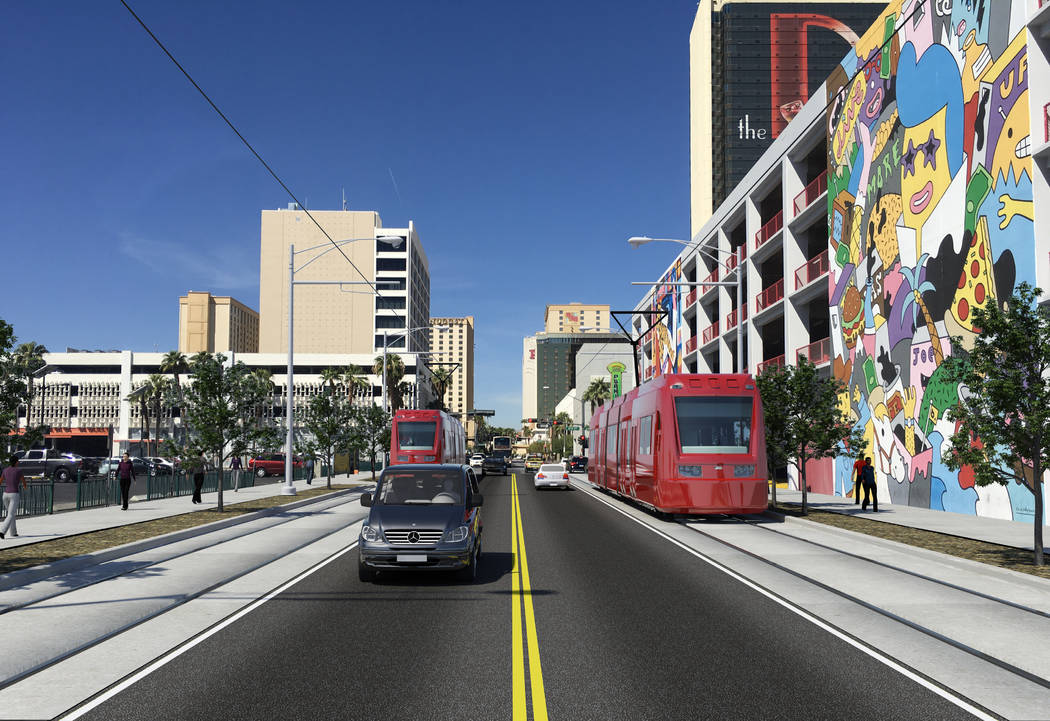RTC head says light rail for Maryland Parkway not completely dead

Though transit officials unanimously voted for an enhanced bus system over light rail for a stretch of Maryland Parkway, Regional Transportation of Southern Nevada CEO Tina Quigley said a rail-based system isn’t completely out of the picture.
Although unlikely, a series of events could reopen the projected $1 billion light rail discussion for the 8.7-mile portion of Maryland, Quigley said Tuesday morning at the RTC’s On Board meeting at Springs Preserve.
“We have the ability later on if … there’s a windfall of money or a new administration would say, ‘We’ll give you 80 percent of the funding,’ then we will have the ability to reconsider,” Quigley said.
It would take about six months to carry out the environmental studies associated with light rail if there is a change of heart, providing a small window for a decision to again look at light rail for the area.
The timeline for such a decision would stretch until just after the 2020 election before the RTC is entirely committed to bus rapid transit, Quigley said.
RTC will carry out preliminary engineering tied to the Maryland project, which at this point could be used toward a bus rapid transit or a light rail system, according to David Swallow, RTC’s senior director of engineering and technology.
The work, slated to start at the beginning of 2020 and last one year, includes topographic surveys, detailed right-of-way and utility research and refined cost estimating, Swallow said.
“That’s kind of the last moment where if we’re going to make any change, where if the board suddenly said, ‘You know what, maybe light rail is the better priority for us and we need to revisit that,’ that’s the time to do it,” he said.
Quigley said that although she was disappointed the board didn’t choose to go with light rail, as it stands now she said it was probably the right choice.
In the buildup to the RTC board of commissioners’ vote last month, RTC officials toured other cities, looking at their light rail systems, which shaped Quigley’s view.
“For years I was a light rail champion; I believed in it,” Quigley said. “We heard a very compelling story for light rail and how it defined a place and kind of created a center of the community and a business district.”
The RTC board of commissioners unanimously chose the bus rapid transit system featuring a dedicated lane and bus stations over the rail system, largely based on cost. That was despite public outreach showing 72 percent of residents favored light rail.
The light-rail plan was billed as a $750 million project for multiple years, but on decision day it was revealed that the cost estimate jumped $250 million to $1 billion after an independent cost assessment commissioned by RTC.
“That was a very big number,” Quigley said. “Especially since we didn’t exactly know when that economic development might happen, and what type of development might happen.”
Quigley said the bus rapid transit system will operate much like the light rail system — using dedicated lanes with forward-thinking technologies. The bus system comes in at a significantly lower cost, running about $345 million to construct.
No tax hike will be required for the bus rapid transit system, RTC documents show.
The possible federal money available for the two options was key, as likely no more than 33 percent of light rail’s $1 billion cost would be taken care of by federal funds while up to 50 percent of the bus rapid transit system would be available for federal money. In the past, up to 80 percent of a light rail project’s cost could be covered by federal money, Quigley said, citing systems in Arizona and California.
Additional money for the light rail system would have had to be approved by voters, via a tax increase, Quigley said.
“That meant our voters would have to pay for the majority of the project,” she said. “If we did have a ballot question to support the funding for this and other transit projects in the valley, if we asked for a quarter-cent sales tax increase that would bring in a bond of $2.5 billion, which means almost half of the money we would ask the voters for, would go to this one 8-mile segment.”
Contact Mick Akers at makers@reviewjournal.com or 702-387-2920. Follow @mickakers on Twitter.